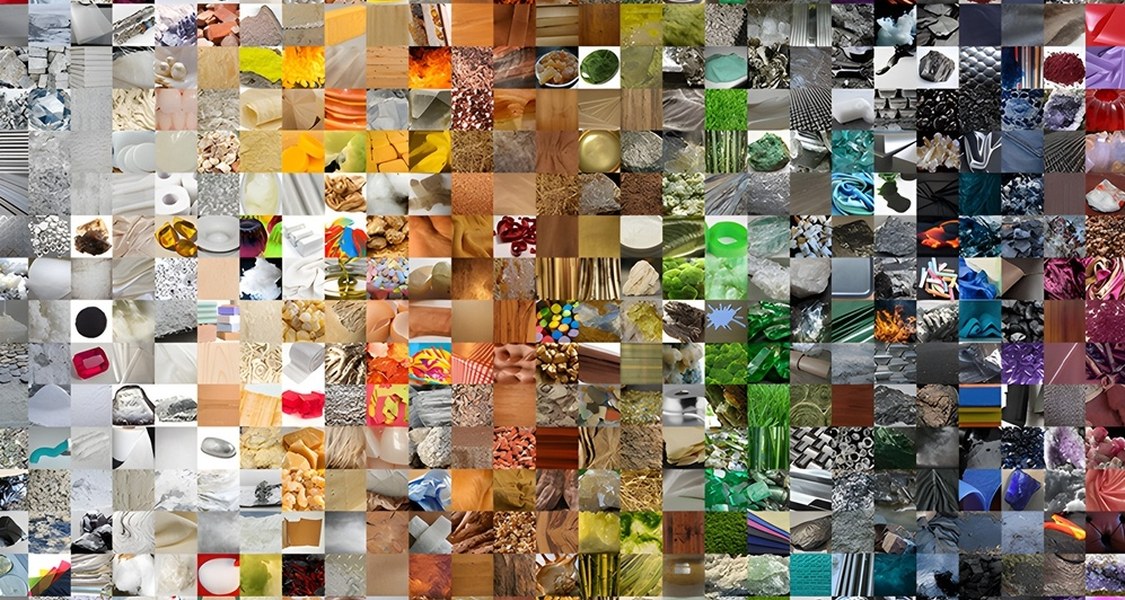06.03.2025 Scientists discover how humans perceive materials
Graininess, blueness, or viscosity: We use just 36 dimensions to represent materials

When we walk about our lives, we rarely think about what the objects around us are made of. Yet, materials impact our lives every day, when picking out clothes, stepping on wet pavement, or stirring a thick bowl of soup. Some materials feel luxurious, like silk, while others are downright unpleasant, like slimy algae. A new study has now achieved an important milestone in explaining how humans make sense of materials. The researchers from Justus Liebig University Giessen, the Max Planck Institute for Human Cognitive and Brain Sciences, and the National Institute of Mental Health have discovered that humans use just 36 dimensions—such as graininess, blueness, or viscosity—to represent the vast diversity of material appearances.
To uncover these dimensions, the team first needed to understand what materials are out there. For this, they assembled an image dataset spanning 200 different material categories.
“It’s the most comprehensive set of its kind,” explains JLU Giessen’s Dr. Filipp Schmidt, the first lead author of the study. “We went through every single noun in the English language to select which categories to include.”
Having identified this list of materials, in a next step, the researchers gathered over a million subjective comparisons from volunteers in a large-scale online study. During the experiment, participants saw three images at a time and had to choose which materials looked most similar. The researchers then fed the responses into an algorithm designed to find the underlying psychological dimensions that explain how we mentally sort materials.
“These dimensions act like coordinates in a multidimensional ‘mental space’: the mind’s way of organizing and comparing materials,” notes Prof. Roland Fleming, one of the authors.
Prof. Martin Hebart, the second lead author of the study, explains how the algorithm works. “Most dimensions will actually be unimportant for most materials,” he says. “For example, viscosity might be relevant for a few specific liquids, like treacle or toothpaste, but for most materials, like wood or plastic, it is largely irrelevant, so the algorithm assigns a value of zero to those materials”.
To confirm what each dimension actually means, the researchers ran another experiment where other participants were asked to work out the dimension’s characteristic. Surprisingly, participants gave highly consistent answers, often using exactly the same words to describe each dimension.
“This shows that the dimensions are really meaningful. They have clear interpretations,” explains Dr. Alexandra Schmid from the National Institute of Mental Health, the study’s fourth author.
The research is not just of interest for those who care about materials. It gets at one of the most important debates in visual neuroscience: how familiar concepts—like buildings, people, letters of the alphabet, or in this case, materials—are represented in the brain. Scientists observed that many brain areas are dedicated to specific kinds of items: one patch for faces, another for letters, for example. Yet, there are common items that don’t seem to have a dedicated brain area. And nobody has identified brain regions associated with different kinds of material, even though there are many cases where these are crucial for everyday decisions and behaviours.
But this ‘cookie-cutter’ view of the brain’s real estate isn’t the only possibility. “Another important organising principle is not to think in terms of specific categories like honey, soil or steel, but in terms of features or dimensions that might be shared by many items. Like the ones we discovered,” suggests Dr. Filipp Schmidt.
The team is now analysing brain scans to test how these newly described dimensions are reflected in brain activity, which can offer a new way to understand how we perceive and interact with the world of materials.
Publication
Schmidt, F., Hebart, M. N., Schmid, A. C., & Fleming, R. W.:
Core dimensions of human material perception.
Proceedings of the National Academy of Sciences, 122 (10) e24172021
https://doi.org/10.1073/pnas.2417202122


